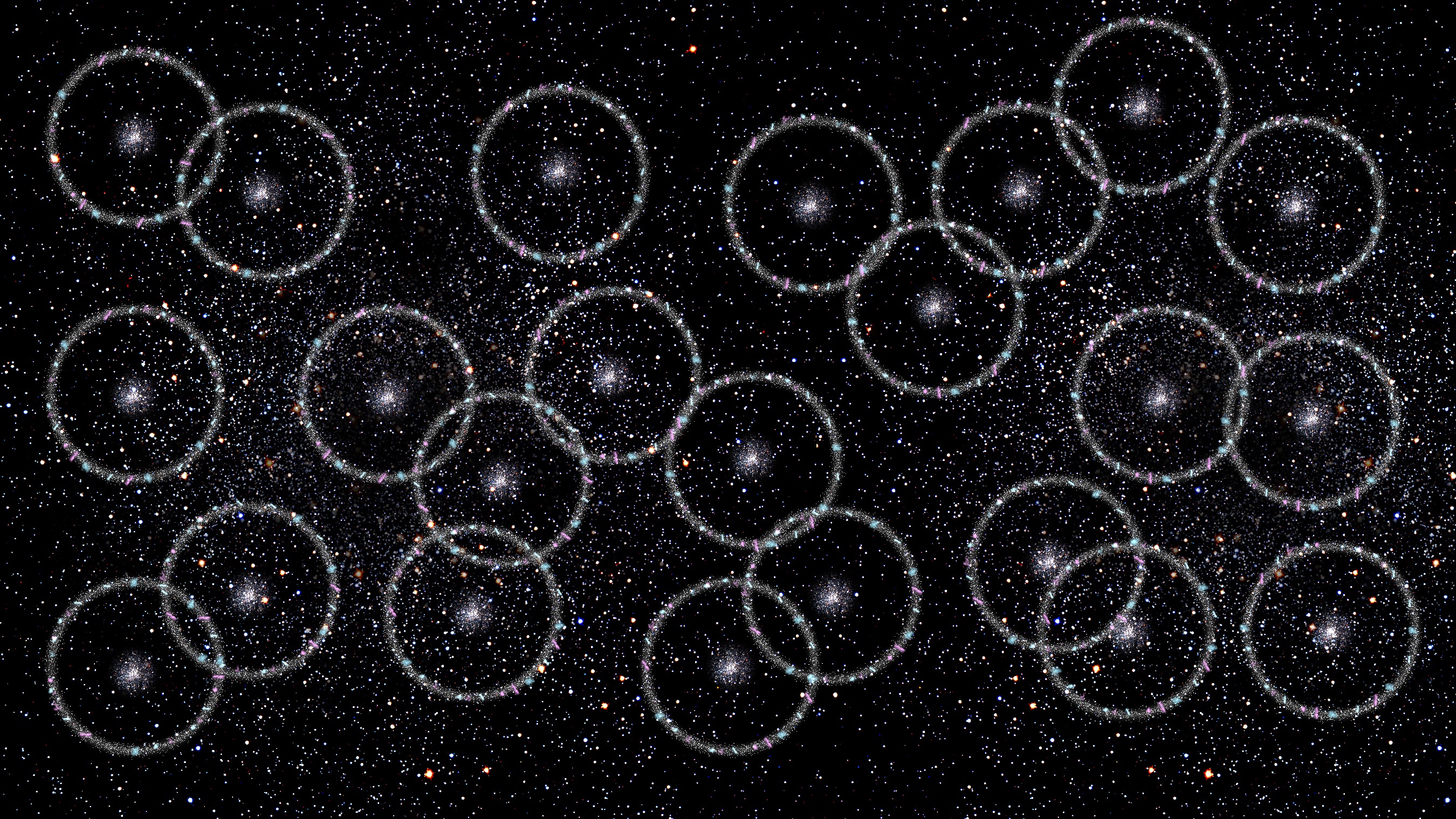Can This Newfound Dark, Massive Galaxy Be Astronomy’s ‘Missing Link’ In The Universe?
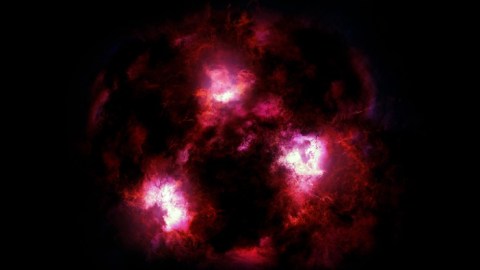
If this newfound galaxy is just the tip of the iceberg, the entire Universe may fall into place.
One of the greatest challenges for a scientist is that every time you make a new advance, it only raises more questions. When we look out at our Universe today, we see galaxies with all sorts of different properties. We see giant ellipticals that haven’t formed stars in billions of years; we see Milky Way-like spirals that are rich in heavy elements; we see irregular galaxies; we see dwarf galaxies; we see ultra-distant galaxies that appear to be forming stars for just the first or second time.
But when you put this all together, there are some puzzles. Some galaxies have grown to be so large so early that they’ve defied a coherent explanation. With only small, low-mass galaxies found at great distances by Hubble, the active formation of a large galaxy has long been astronomy’s missing link. With a new discovery of a dark, massive galaxy, astronomers may have just cracked the mystery, and solved a longstanding cosmic puzzle.
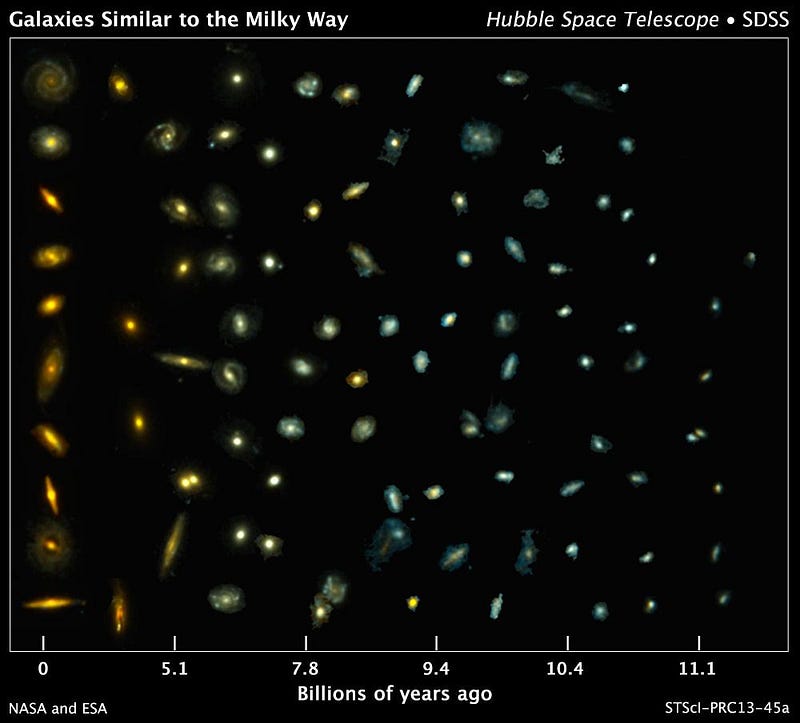
To understand how galaxies form and grow up in our Universe, it’s always best to start at the very beginning. Cosmologists have assembled a comprehensive and coherent picture of the Universe, and if we trace out how that Universe evolves and grows from its humble beginnings to the cosmos we inhabit today, we should be able to come up with a story that tells us what we ought to see.
The Universe, in the aftermath of the Big Bang (post-inflation), arrives on the scene with the seeds for our modern-day galaxies already planted. Our Universe is hot, dense, expanding, and filled with matter, antimatter, dark matter and radiation. It’s also born almost perfectly uniform, but with tiny density imperfections in it. On all scales, the densest regions are just a few parts-in-100,000 denser than average, but that’s all the Universe needs.
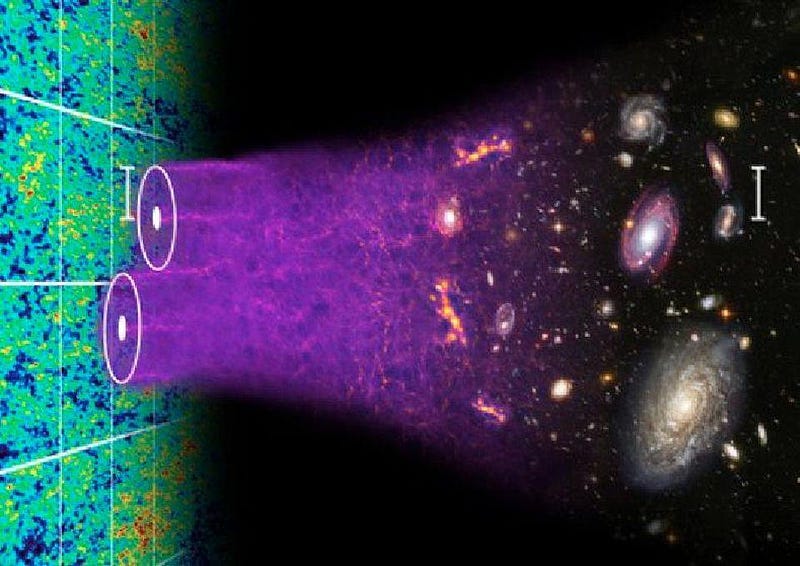
As the Universe expands and cools, the regions that have slightly more matter (normal and dark combined) than others will begin to preferentially attract more and more of the matter from surrounding regions towards it. As time goes on, radiation becomes less important, and these matter imperfections can grow at a faster rate as they continue to grow in density.
Although it takes somewhere between 50 and 100 million years for the very first region in the Universe to become dense enough to form stars, that’s just the start of the story. These first stars, once they start turning on, herald the arrival of energetic, ultraviolet photons that start streaming through the Universe. Over time, as stars form in more and more locations, the neutral atoms throughout space begin to be reionized, as the Universe slowly becomes transparent to visible light.
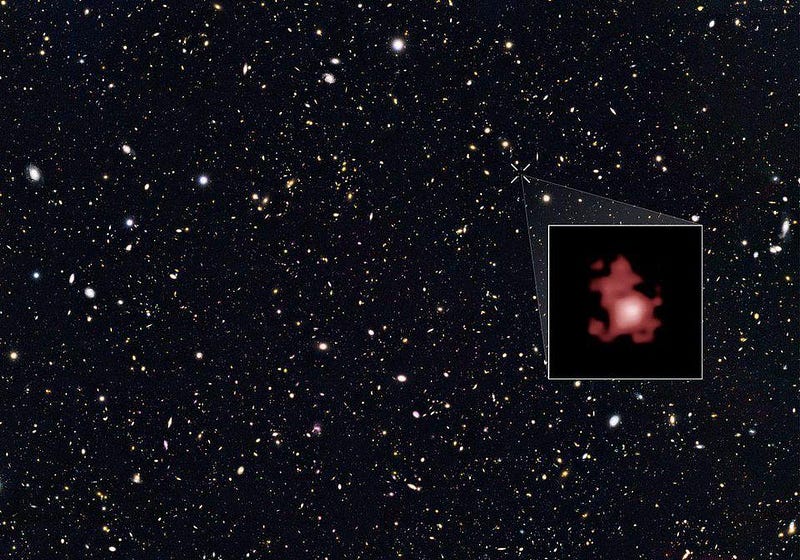
At around 200–250 million years after the Big Bang, the first galaxies begin to form, increasing the rate of reionization as star-forming regions cluster and merge together. The earliest galaxy we’ve ever identified (with today’s instrumentation limits) appears about 400 million years after the Big Bang, with all the earliest galaxies actively forming stars at an alarming rate, but no more massive than 1% the mass of our modern Milky Way.
After a total of 550 million years, the Universe finally becomes fully reionized, and light can freely travel without being absorbed. Yet we continue to see only these bright but low-mass galaxies for some time, until about a billion years after the Big Bang, when enormous galaxies even more massive than our Milky Way appear in our telescopes. The big puzzle here is the missing link between these two populations.
In theory, the way these cosmic structures should form is through gravitational growth and mergers. Individual proto-galaxies should attract the matter from surrounding regions of space, while different proto-galaxies should attract one another. As time goes on, the gravitational influence of the various galaxies starts to affect larger and larger scales, leading to galaxies growing by eating one another and merging together.
But if that were the case, we wouldn’t expect to see only the small, early proto-galaxies and the large, mature, post-merger galaxies. We would expect to see that intermediate stage, where the proto-galaxies are merging together, during the growth phase where star-formation is actively occurring. But all of the early galaxies we’ve seen aren’t forming stars at a fast enough rate to explain these mature galaxies.
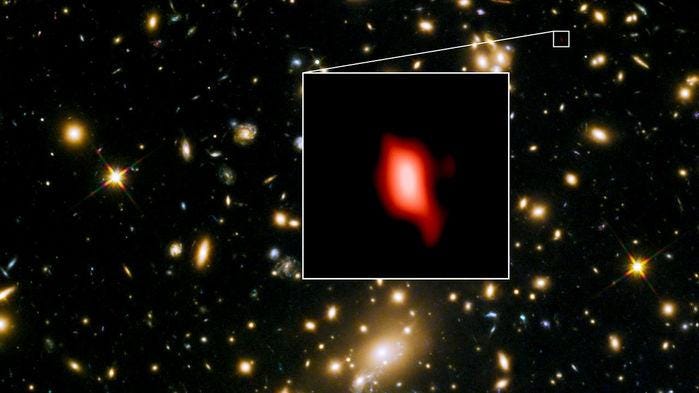
The standard expectation is that there’s got to be some undiscovered type of galaxy in between these low-mass, early-type proto-galaxies and the heavy, massive, mature galaxies that we see. For those elusive galaxies to not appear in the same surveys that find both of the other types of galaxies means there must be something that’s obscuring the light we’re expecting to arrive.
For the most distant galaxies that are actively forming new stars at the greatest rates, we expect the light they’ll emit will peak in ultraviolet wavelengths, just like they do for all massive star-forming regions where the light is dominated by stars significantly more massive than the Sun. After traveling through the expanding Universe, that light should redshift from ultraviolet through the visible part of the spectrum and all the way into the infrared. Yet our deepest infrared observations reveal only the early and late-type galaxies, not the intermediate type.
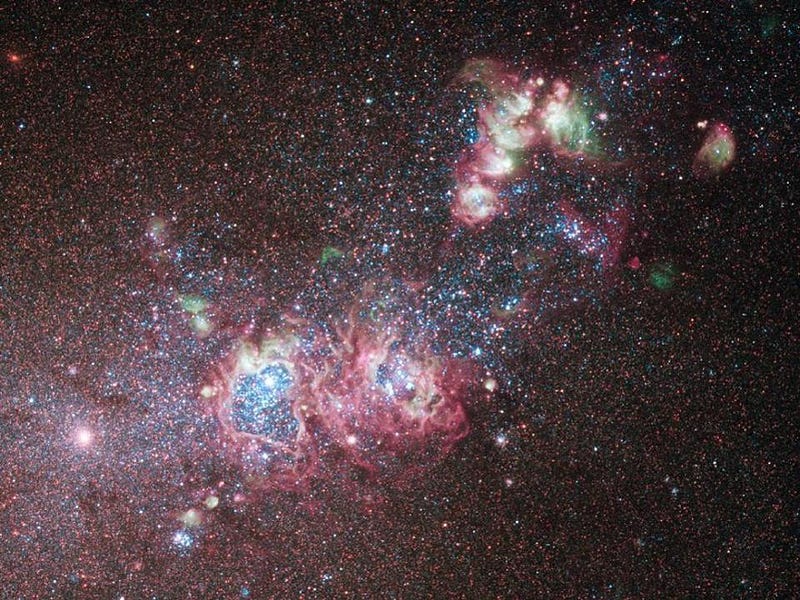
Why could this be? The simplest explanation would be if something were blocking that light somehow. By the time the Universe is in the process of forming these very massive galaxies, it’s already reionized, so we cannot blame the intergalactic medium for absorbing the light. But what might be a reasonable culprit is the gas and dust that belongs to the proto-galaxies which merge to form the late-type galaxies we eventually see.
Whenever you have a star-forming region, even if that region encompasses the entire galaxy, those stars are only able to form where you have neutral gas clouds collapsing. But neutral gas is exactly what we expect to block ultraviolet and visible light by absorbing it, and then re-radiating it at much longer wavelengths, dependent on the gas temperature. That light should be radiated in the infrared, and ought to be redshifted far into the microwave or even radio bands.
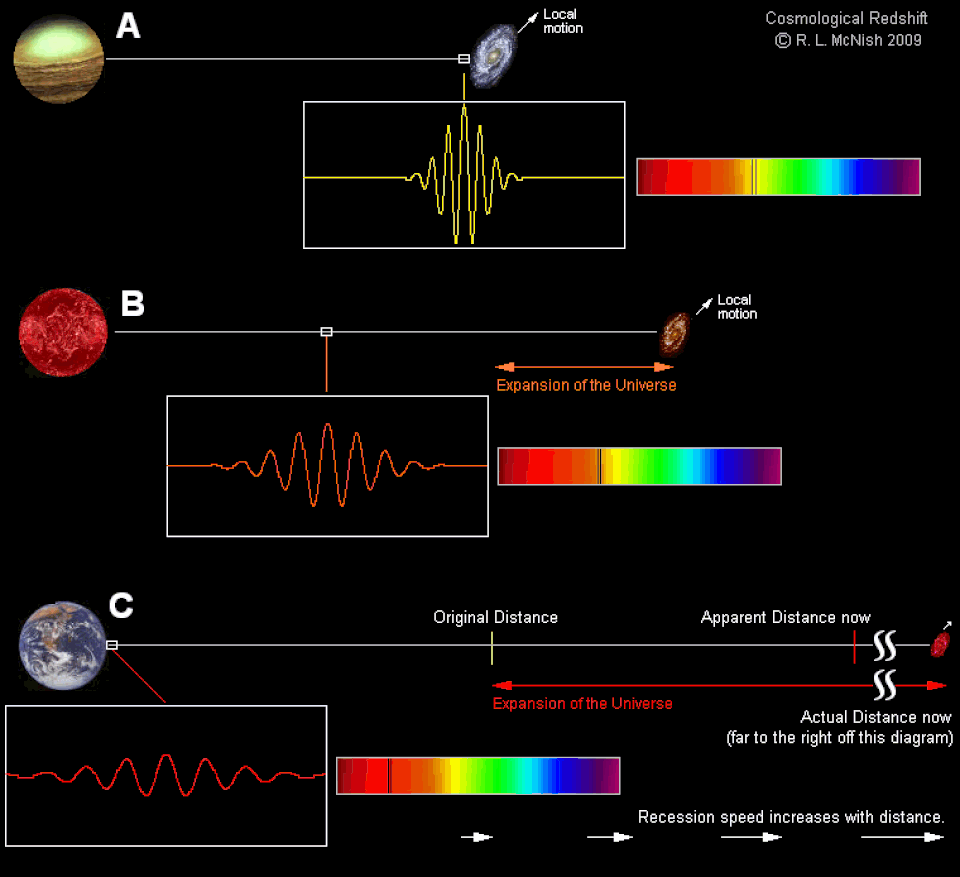
So instead of looking for redshifted starlight, you’d want to look for the signatures of warm dust that gets redshifted by the expansion of the Universe. You wouldn’t use an optical/near-infrared observatory like Hubble, but rather a millimeter/submillimeter array of radio telescopes.
Well, the most powerful such array is ALMA, the Atacama Large Millimeter/submillimeter Array, which contains a collection of 66 radio telescopes designed for achieving high angular resolution and unprecedented sensitivity to detail in exactly that critical set of wavelengths. If you can find a faint, distant source of light that appears in these wavelengths and no others, you’ll have discovered a candidate for exactly this type of “missing link” in galaxy formation. For the first time, a team of astronomers appears to have struck gold with exactly this discovery, by pure luck, in their observing field.
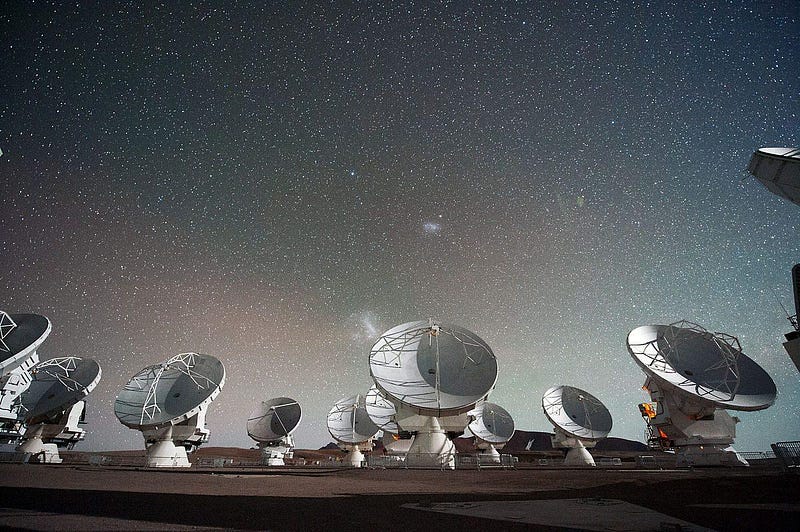
They made this discovery by looking at galaxies in the COSMOS field, a deep-field set of observations where many different observatories, including both Hubble and ALMA, have taken copious amounts of data. The team found two signals that corresponded to galaxies filled with warm dust and, therefore, rapid amounts of star formation. One of these corresponded to a run-of-the-mill late-type galaxy, but the other corresponded to no known galaxy at all.
When all the observations of this new galaxy candidate were combined, the astronomers studying it determined that it was:
- very massive, with nearly 100 billion solar masses worth of stars and even more in neutral gas,
- a star formation rate of 300 new solar masses’ worth of stars every year (hundreds of times what we find in the Milky Way),
- extremely highly obscured, as though it were shrouded in light-blocking dust,
- and incredibly distant, with its light coming to us just 1.3 billion years after the Big Bang.
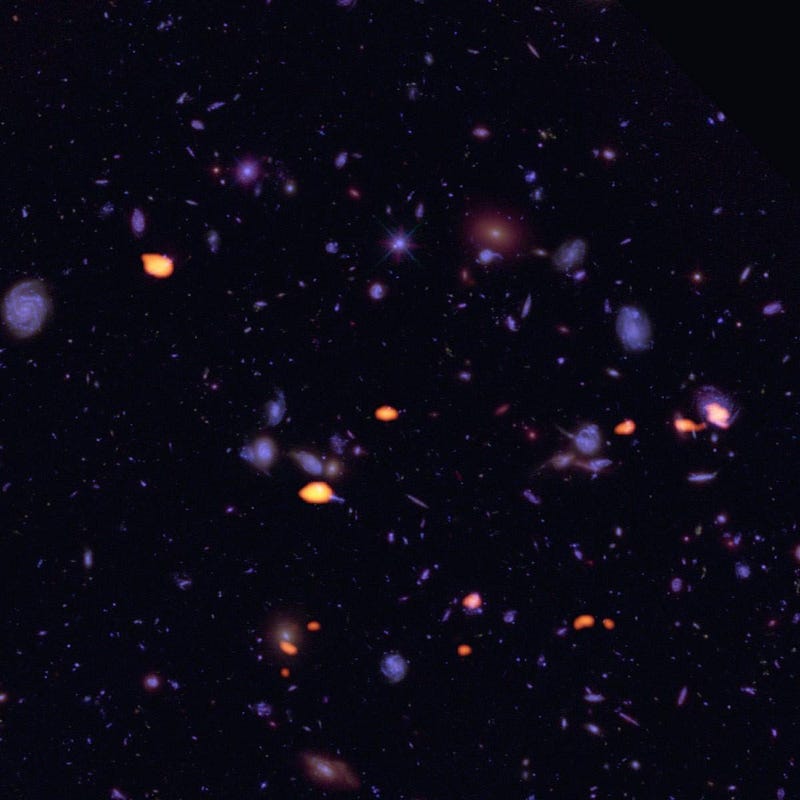
The study’s authors have expressed extreme excitement that this galaxy — which appears in a survey area of just 8 square arcminutes (it would take 18 million such regions to cover the sky) — might be a prototype for the “missing link” galaxies required to explain how the Universe grew up. According to study author Kate Whitaker,
“These otherwise hidden galaxies are truly intriguing; it makes you wonder if this is just the tip of the iceberg, with a whole new type of galaxy population just waiting to be discovered.”
While other large galaxies, including star-forming galaxies, had been spotted before, none of them had large enough star-formation rates to possibly explain how the Universe’s galaxies grew up so fast. But this galaxy changes all of that, according to first author Christina Williams, who noted,
“Our hidden monster galaxy has precisely the right ingredients to be that missing link, because they are probably a lot more common.”
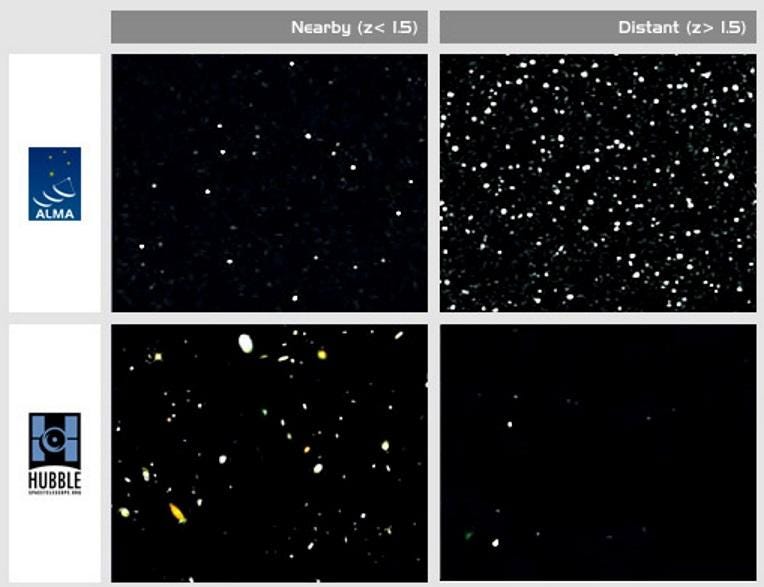
Up until now, scientists have been waiting for the James Webb Space Telescope — humanity’s next-generation, space-based infrared observatory — to peer through the light-blocking dust and solve the mystery of how our Universe grew up. While Webb will certainly teach us more about these early, growing galaxies and reveal details that remain unseen, we’ve learned that these obscured monsters really are out there, and might be the missing link in galaxy growth and evolution.
Either we’ve gotten incredibly lucky in finding a very rare type of galaxy in such a small region of space, or this new find is an indicator that these behemoths really are everywhere. For now, this new discovery should leave us all hopeful that ALMA will continue to find more of these galaxies, and that when James Webb comes online, one more piece of the cosmic puzzle might slide perfectly into place.
Ethan Siegel is the author of Beyond the Galaxy and Treknology. You can pre-order his third book, currently in development: the Encyclopaedia Cosmologica.




